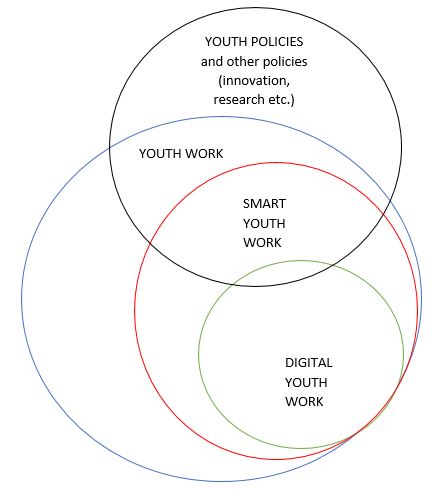Digital Youth
3.3. Estonian approach to smart youth work
By Anne Kivimäe
The approach Estonia took when developing its approach to the smart youth work originates in the discussions held during the development of new national youth strategy in 2012-2013.
The term digital youth work was by then used by different stakeholders; also there were other terms used in the field practice, including online youth work (for example also in the Declaration of the 2nd Youth Work Convention, 2015), cyber youth work (see for example here and here), virtual youth work (see http://virtualyouthwork.com/ as an example) etc. The variety in terminology is still existing in different countries and institutional contexts to describe youth work that aims to embrace digital media and technology. In most cases the focus seems to be on the delivery of youth work – on specific tools and settings of youth work practice.
The word “smart” was by that time related in the EU context more with energy, cities, growth, economy, digitalisation, specialisation etc. As an example, the European Commission’s Cohesion Policy, that aims to reduce differences between regions and to ensure growth across Europe and refers to efficiency and management as a crucial factor for many regions in Europe to overcome the economic crisis. In the framework of the Cohesion Policy, to develop a Research and Innovation strategy for Smart Specialisation was a prerequisite in order to receive funding from the European Regional Development Fund. The Smart Specialisation Platform assists Member States and regions to develop, implement and review their strategies. These include a focus on identifying niche areas of competitive strength, solving major societal challenges – bringing in a demand-driven dimension, innovation partnerships emphasizing greater co-ordination between different societal stakeholders and aligning resources and strategies between private and public actors of different governance levels.
In an attempt to include both: the need for youth work that can address the interest and needs young people have in connection with digital technologies and build new solutions in youth work using digital technologies; but also the need to find innovative ways to develop youth work agenda further – including in policy, research and strategical planning for youth work; the term “nutikas noorsootöö” – smart youth work – was invented.
When the Government approved the new Youth Field Development Plan 2014-2020, it included an objective to develop a concept paper for smart youth work to support achieving the aim „Increase opportunities for young people to develop their creativity, show initiative and act together“.
The Youth Affairs Department of the Ministry of Education and Research used this visual description in order to explain Estonian understanding of smart youth work (A. Rohtla, 2017):

In autumn 2016, the Ministry of Education and Research convened a working group in the youth field on the topic of smart youth work. The aim of the working group was to articulate the content of smart youth work and map out the challenges. Besides the Ministry of Education and Research, the working group included representatives from the Permanent Representation of the Republic of Estonia to the EU, the Estonian Youth Work Centre, the Archimedes Foundation’s Youth Agency, the Association of Estonian Open Youth Centres, the Association of Estonian Hobby Schools, the Estonian Council of Youth Workers and the Estonian National Youth Council.
The working group highlighted three main focus areas in smart youth work:
- activities aimed at youths;
- development needs of youth workers for implementing smart youth work;
- developing quality of youth work and a better knowledge of youths using digital means.
Based on the work of the working group, a concept paper with a strategy to develop smart youth work was created. The strategy sets out a general framework for planning and implementing further activities on smart youth work topics.


